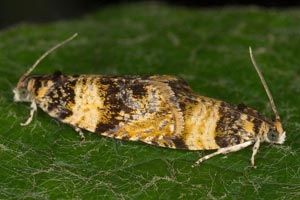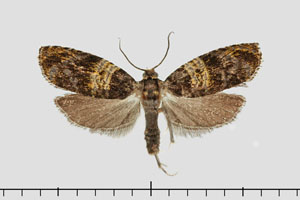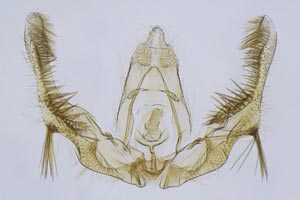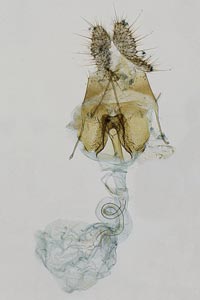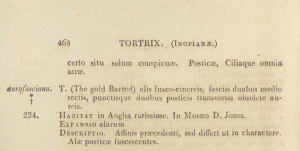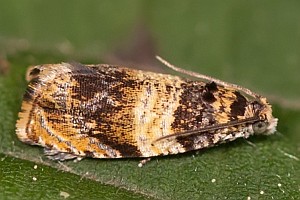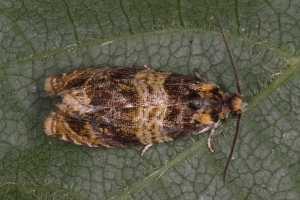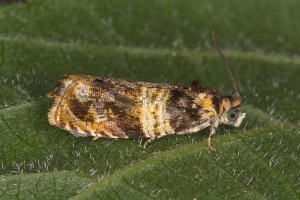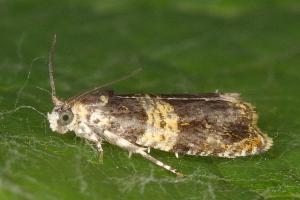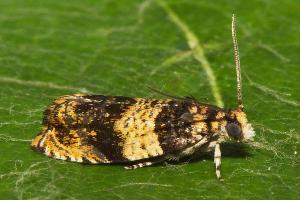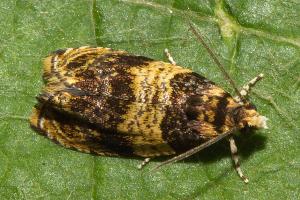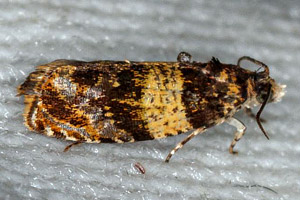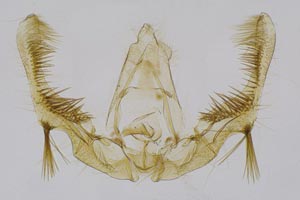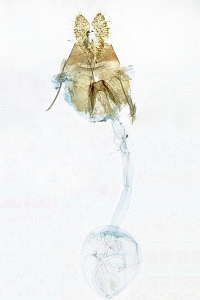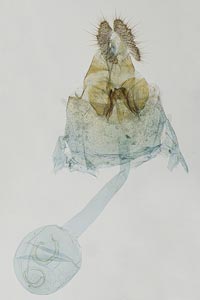

 +25Kontinente:EUAS
+25Kontinente:EUAS1. Lebendfotos
1.1. Falter
1.2. Kopula
2. Diagnose
2.1. Geschlecht nicht bestimmt
2.2. Genitalien
2.2.1. Männchen
2.2.2. Weibchen
2.3. Erstbeschreibung
3. Biologie
3.1. Nahrung der Raupe
Trotz vieler Angaben ist die Raupennahrung dieser Art noch weitgehend unbekannt!
Bei Anikin et al. (2017: 165) heißt es lapidar: "L: Musci."
Wilkinson (1859: 273-274) wusste noch nichts zur Raupe. Bei Meyrick (1895: 457) heißt es dann zu "Exartema latifasciana": "Larva pale yellow; head black; plate of 2 reddish: in galleries in moss (Hepatica) on tree-trunks; 4, 5." Dies dürfte keine Primärangabe gewesen sein.
Bei Barrett (1906: 70) ist dann sehr viel ausführlicher zu lesen: "Larva shining pale yellow, with the alimentary canal in places showing blackish green; head round, black; thoragic plate reddish; anal plate rather large, shining, reddish or reddish black." Und zur Lebensweise heißt es: "April and May. "Feeding in silken galleries in the small patches of Hepaticae which grow on smooth-barked trees as lilac, ash, &c. There is no visible external sign of the presence of the larva within the tufts of liverwort, but if these are gently sundered from the trunks the galleries at once become visible; these are of thick white silk, covered with gnawings from the bark and debris of the liverwort." (W. Warren.) Other writers say upon plum, cherry, oak and birch trees."
Kennel (1916: 433) machte daraus: "Cytolomia latifasciana Hw. [...] Die Raupe ist blaßgelblich, der Kopf schwarz, Nackenschild rötlich; sie lebt im April und Mai in Gespinnströhren zwischen dem Moos an Baumstämmen, wurde auch in faulem Holz von Prunus, Quercus, Betula gefunden, wohin sie sich aber wohl nur zur Verpuppung begeben hatte."
Schütze (1931: 11-12) teilte später zusammenfassend mit: "Exartema latifasciana Haworth. Raupe Juni [...] In röhrenförmigen Gängen zwischen Baummoos (Schmid), in faulem Holz von Prunus domestica, Prunus cerasus, Quercus, Betula und so weiter (Sorhagen). Schleich fand an einem Buchenstamm einem aus dem Moos vorragenden, etwa 1 cm langen, von feinen Moosteilchen gefertigten Sack angesponnen, der große Ähnlichkleit mit dem von Taleporia hatte. (Hering). Biologie unklar! (Schütze)". "Biologie unklar!" war dabei die treffendste Formulierung!
Bei Hancock et al. (2015: 58) wurde daraus: "Ovum. Laid in June - July amongst moss on the bark of the trunk of various trees, includung Quercus, Malus, Prunus, Betula, or amongst liverworts on smooth barked trees such as Ligustrum vulgare and Fraxinus (Barrett, 1906)." Es gibt also nichts Neues, nur dass aus den alten Literaturangaben zu Raupen unzulässig (!) auf die Eiablagestellen geschlossen wurde.
Und wovon sich die Raupe denn jetzt tatsächlich ernährt (Lebermoose, zerfallende Rinde von Laubbäumen, Pilzhyphen ?), scheint noch immer ungeklärt zu sein - mit Laubmoosen scheint die Art nichts zu tun zu haben.
(Autor: Erwin Rennwald)
4. Weitere Informationen
4.1. Etymologie (Namenserklärung)
Lateinisch aurum = Gold, fascia = Binde.
4.2. Andere Kombinationen
- Tortrix aurofasciana Haworth, 1811 [Originalkombination]
4.3. Synonyme
- Celypha latifasciana Haworth, 1811
- Cymolomia latifasciana (Haworth, 1811)
- Celypha venustana Froelich, 1828
4.4. Publikationsjahr der Erstbeschreibung
Wir übernehmen hier die von Heppner (1982) angegebenen Publikationsjahre.
4.5. Literatur
- Anikin, V.V., Sachkov, S.A. & V.V. Zolotuhin (2017): "Fauna lepidopterologica Volgo-Uralensis": from P. Pallas to present days. — Proceedings of the Museum Witt Munich, Volume 7: 1-696; Munich and Vilnius.
- Barrett, C.G. (1905)[-1907]: The Lepidoptera of the British Islands 11. Heterocera. Tortricina: i-lxxv, 1-293. London (Lovell Reeve and Co. Limited). [Digitalisat auf biodiversitylibrary.org]
- Groenen, F., Prick, M. & A. Schreurs (2017): Celypha aurofasciana (Lepidoptera: Tortricidae) na bijna 130 jaar weer terug in Nederland. — Entomologische berichten 77 (5): 240-242. [PDF auf nev.nl]
- Hancock, E.F., Bland, K.P. & J. Razowski (2015): The moths and butterflies of Great Britain and Ireland. Volume 5 (Part 2). Tortricidae, Olethreutinae. - 377 S.; Leiden & Boston (Brill).
- Erstbeschreibung: Haworth, A. H. (1803-1828): Lepidoptera britannica; sistens digestionem novam insectorum lepidopterorum quæ in Magna Britannia reperiuntur, larvarum pabulo, temporeque pascendi; expansione alarum; mensibusque volandi; synonymis atque locis observationibusque variis: I-XXXVI, 1-609. Londini (R. Taylor).
- Heppner, J. B. (1982): Dates of selected Lepidoptera literature for the western hemisphere fauna. — Journal of the Lepidopterologists' Society 36 (2): 87-111.
- Kennel, J. (1908-1921): Die Palaearktischen Tortriciden. Eine monographische Darstellung. — Zoologica, 21 (54): 1-546. [PDF auf zobodat.at]
- Meyrick, E. (1895): A handbook of British Lepidoptera. - vi+843 pp.; London.[Digitalisat auf biodiversitylibrary.org]
- Razowski, J. (2001): Die Tortriciden (Lepidoptera, Tortricidae) Mitteleuropas. Bestimmung - Verbreitung - Flugstandort - Lebensweise der Raupen. — 319 S.; Bratislava.
- SCHÜTZE (1931): 12
- Wilkinson, S. J. (1859): The British Tortrices. i-viii, 1-328, pl. I-IV. London (John van Voorst). [Digitalisat auf biodiversitylibrary.org]


























